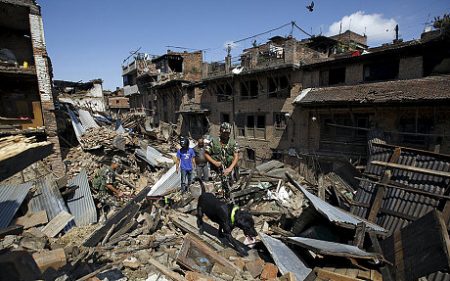November 21, 2017 – Last month at The Geological Society of America’s 2017 (GSA) conference in Seattle, Roger Bilham, of University of Colorado at Boulder, and Rebecca Bendick, of University of Montana, presented a provocative hypothesis linking increased frequency of earthquakes with the slowing in the rotation of the Earth. They noted that on five different occasions over the last century there was a 25 to 30% increase in the number of significant earthquakes coincident with Earth’s variable rotation.
What are these geologists talking about? Isn’t Earth’s rotation consistent?
Astronomers tracking the Earth’s rotation have known for a long time that we may have a 24-hour day but Earth itself doesn’t conform to our fixed 24-hour schedule. That’s because the Earth is not a single, solid, uniform mass. First described in a 1960 book written by W. H. Munk and G. J. F. MacDonald, entitled “The Rotation of the Earth: a Geophysical Discussion,” it described the interaction of atmosphere, oceans, continental plates, a dense fluid core, a less dense fluid mantle, and the presence of the Moon, with the spinning Earth and its axial wobble. If you don’t know about the wobble, our current axial tilt is 23.5 degrees from the vertical plane. But that changes over a 40,000-year cycle, from 22.1 to 24.5 degrees producing not just rotational impacts but climate ones as well.
So the Earth’s rotation based on what is described in the previous paragraph is not consistent. These changes are a matter of milliseconds, but it appears milliseconds matter when dealing with an enormous mass like the Earth. The two geologists discerned a pattern in the variability of rotation speed correlating to seismic activity. They did this by looking at historic earthquake records and known changes in Earth’s rotational speed over time. This allowed them to hypothesize that changes in Earth’s rotation lead to increased seismic activity within a known 24 to 33-year observed oscillation, occurring 5 to 6 years after an observed deceleration.
The geologists describe the phenomenon of deceleration as similar to a loose cannon sliding across the deck of a rolling ship. In this case, the cannon equates to the Earth’s lithosphere, the crust that lies above the mantle (the deck in the analogy).
We think of the lithosphere as solid but clearly, earthquakes demonstrate that it is not. The geologists further noted that the areas most sensitive to increased seismic activity are not distributed equally across the globe, and point to the zone lying between 10 degrees north and 30 degrees south latitude as most seismically sensitive to deceleration. In their GSA presentation, they describe the eastern Caribbean along the plate boundary as a good example of this seismic increase with more than 80% of magnitude 7.0 or greater earthquakes occurring 5 years after maximum noted rotational deceleration. One of those, the Haitian earthquake occurred in 2010, within the timeframe of their hypothesis.
Does this give countries within the 40-degree latitude parameters described above an advantage in disaster planning?
Bilham and Bendick state ithat “the year 2017 marks six years following a deceleration episode that commenced in 2011, suggesting that the world has now entered a period of enhanced global seismic productivity with a duration of at least five years.” With this quote it is no wonder that numerous headlines soon appeared in mainstream media stating we should expect bigger earthquakes in 2018.
In The Huffington Post the science writer exclaimed that “the number of severe quakes could triple next year.”
Another headline chose to add a pun to its headline stating, “Scientists shocked by huge discovery about earthquakes.” It juxtaposed the headline with a picture of Kathmandu, Nepal after the April 2015 seismic event that killed 9,000 and injured 22,000 more. But it didn’t note that Kathmandu, at 27 degrees north latitude, lay 17 degrees above the zone of deceleration identified by Bilham and Bendick as most seismically sensitive.
So what should we expect in terms of increased significant seismic events if this hypothesis is correct?
On average Bilham and Bendick describe a potential increase between 66 and 100% in significant seismic events after a rotational slowdown. So from an average of 15 large quakes per year, we may see the numbers increase to between 25 and 30. So triple the number isn’t likely.
But not to be an alarmist, in case you missed it, in September, Mexico got rocked by two significant quakes, both exceeding magnitude 7.0.
And this month is turning out to be seismically active with three significant quakes beginning with a magnitude 7.3 striking along the Iran-Iraq border on November 13th; a magnitude 6.9 hitting Southern China three days ago; and the latest, yesterday, a magnitude 7.0 event striking off New Caledonia in the Pacific Ocean and setting off a tsunami warning. Only the last of these seismic events falls within the zone of increased seismic activity as hypothesized by the Bilham and Bendick. And if you want to stay on top of all the seismic activity on our planet then I suggest you visit Earthquake-Report.com, a site that describes itself as “the best independent earthquake reporting site in the world.”









